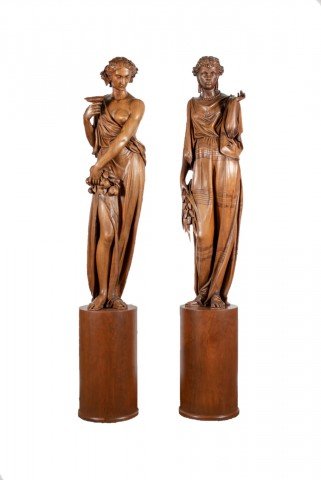Alexandre-Georges Fourdinois and his son Henri Fourdinois (1830-1907) were two of the most pre-eminent ébénistes of the nineteenth century, working during the years from 1835 to 1887, and executing many royal commissions including for Napoléon III, the Empress Eugénie and the King of Spain, Alfonso XII. Examples of their work may be seen at the Château of Compiègne, the Metropolitan Museum in New York and the Victoria & Albert Museum, London.
Alexandre-Georges was a highly important furniture maker of the Second Empire. His business at 38 rue Amelot was founded with Jules Fossey in 1835, moving to number 46 in 1853. He was created an Officer of the Legion d Honneur in 1863.
Henri spent two years in London with the silversmith Jean-Valentin Morel, returning to Paris to design for the important bronzier Paillard, and then worked with his father from 1860, finally taking over the business in 1867. He worked very much in the style of his father.
Both father and son pioneered an elaborate revived renaissance style, and became known for their elaborate and high quality carved work. However, the Empress Eugénie led the return to the fashions of the Louis XVI period and Fourdinois, who were constantly employed to execute Royal commissions at all the Royal households, are recorded as making furniture in the Louis XVI style from 1855 (the first recorded being a cheval mirror for the Mobilier Nationale).
The prestigous Victoria & Albert Museum in London holds a Cabinet by Fourdinois that was purchased by its predecessor, the South Kensington Museum. This museum was founded with a stated aim of providing models of the finest craftsmanship for young designers and artisans in England. The displays at the Great Exhibition of 1851 in London had shown the British government how far ahead the French were in terms of design, and the government feared that France would consequently overtake Britain in the success of its manufacturing industries and craft trades. Therefore at the International Exhibition in Paris in 1855 the British government was a keen purchaser for the new museum. The Fourdinois cabinet won a Grand Medal of Honour at the 1855 exhibition and was greatly admired for the skill of its carving. The british government paid £320 for it. Records also show they purchased another elaboratly carved cabinet from Fourdinois at the 1867 Exhibition.
Furniture by both the father and son is rarely seen on the open market.

